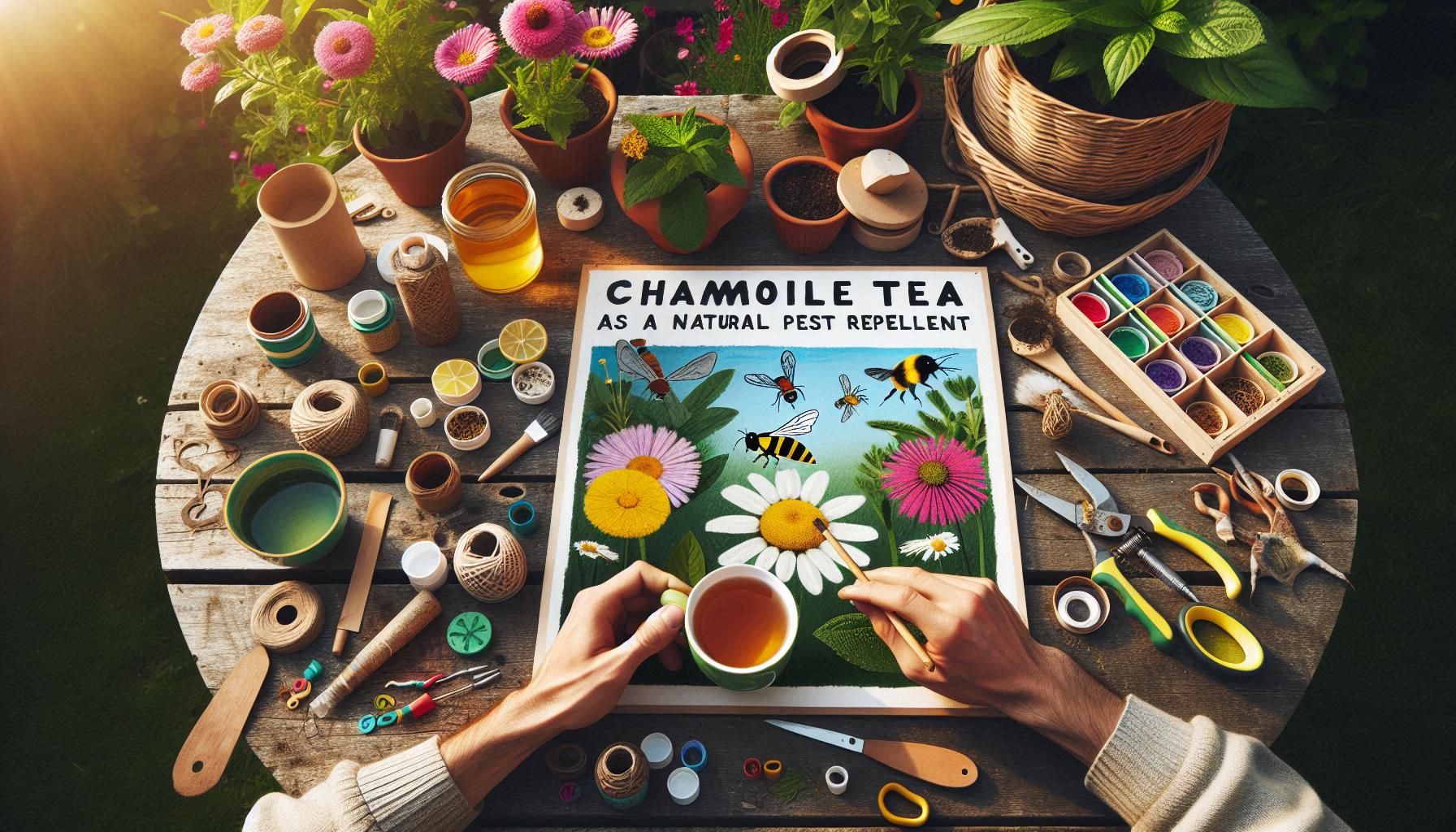Use Chamomile Tea in Your Garden for a Natural plant Boost
Are your garden plants looking a little droopy? Is your once-thriving vegetable patch now more of a sad salad? Fear not, fellow green thumbs! Grab your favorite teacup because we’re about to spill the tea – literally! That’s right, Use Chamomile Tea in Your garden for a Natural Plant Boost and watch your plants perk up faster than you can say “herbal remedy.” Not only does chamomile tea smell delightful and taste fabulous (hello, relaxation!), but it also packs a nutritious punch for your garden.Packed with vitamins and natural fungicides, chamomile tea isn’t just a soothing sipper for you; it’s a miracle elixir for your garden’s leafy friends. So, if you’re ready to transform your garden from drab to fab while enjoying a cup of chamomile, stick around – your plants are in for a treat!
Understanding the Benefits of chamomile Tea for Garden Health
Chamomile tea isn’t just a soothing beverage; it offers a multitude of benefits for garden health. The antiseptic properties of chamomile can definitely help to reduce fungal diseases while promoting healthy growth in plants. When applied as a foliar spray, chamomile tea acts as a natural fungicide and can ward off common garden pests, such as aphids and spider mites.A routine request every few weeks can provide plants a protective barrier, reducing the need for chemical interventions.
Additionally, using chamomile tea as a soil drench can enhance nutrient absorption in plants.The natural compounds in chamomile can stimulate beneficial microbial activity in the soil, leading to improved fertility and stronger root systems. Here are some advantages of incorporating chamomile tea into your gardening regimen:
- Natural pest Deterrent: Helps to manage pests without harmful chemicals.
- Fungal Disease Prevention: Reduces incidence of fungal infections.
- Enhanced Soil Health: Stimulates beneficial bacteria and improves nutrient uptake.
- Promotes Plant Longevity: Supports overall plant health and longevity.

How Chamomile Tea Acts as a Natural Pest Repellent
Chamomile tea isn’t just a soothing beverage; its natural properties make it an effective pest deterrent in the garden. The essential oils found in chamomile contain compounds that repel common pests like aphids,spider mites,and even mosquitoes. By using chamomile tea as a spray, gardeners can create an environment that discourages these unwelcome visitors without resorting to harsh chemicals. Not only is this approach safer for beneficial insects, but it also enhances the overall health of the plants. To create your own pest-repellent mixture,steep chamomile tea bags in water and let it cool before transferring it into a spray bottle for easy application.
In addition to being a repellent, chamomile tea can also boost the resilience of your plants against infestations. Its anti-fungal and anti-bacterial properties help to protect against diseases that weaken plants and make them more susceptible to pests. Consider applying chamomile tea directly to the soil or as a foliar spray, and watch your garden thrive. A simple comparison of the benefits might include:
| Chamomile Tea benefits | Effect on Plants |
|---|---|
| Natural Pest Deterrent | Reduces aphid and mite populations |
| Boosts Plant Health | Fights fungal and bacterial diseases |
| Encourages Beneficial Insects | Attracts pollinators and predators of harmful pests |

Boosting Soil Nutrients: The Role of Chamomile Tea in Compost
Chamomile tea is not just a soothing beverage but a powerful ally in enhancing the nutrient profile of your compost. When brewed and used correctly, chamomile tea can introduce essential nutrients such as calcium, potassium, and magnesium, which are crucial for robust plant growth. the infusion of this herbal tea into your compost heap can promote the breakdown of organic materials, leading to a more fertile end product. Additionally, chamomile possesses natural antifungal properties, which can definitely help combat common pathogens in the composting process, thus improving the overall health of your soil.
Incorporating chamomile tea into your compost routine is simple and effective. Here are some tips to get you started:
- Use brewed tea: Prepare chamomile tea without any additives like sugar or milk, then allow it to cool.
- Mix into compost: Pour the cooled tea directly onto your compost pile, ensuring even distribution.
- Frequency: Repeat this process every few weeks to continuously enrich your compost.
This method not only enhances the nutrient content but also encourages beneficial microorganisms in the compost, thereby creating a thriving environment for natural decomposition. Your garden plants will flourish with the nutrient-rich compost enhanced by chamomile, leading to healthier and more vibrant growth.

Using Chamomile Tea to enhance Seed Germination and Growth
Chamomile tea can be an excellent natural solution for gardeners looking to boost seed germination and promote healthy growth. The secret lies in chamomile’s natural properties, which help suppress fungal pathogens that can hinder seed development. Not only does chamomile tea provide essential nutrients, but it also creates a beneficial environment for roots to thrive. By soaking seeds in chamomile tea before planting, you can increase germination rates significantly. To prepare the tea, steep a few chamomile tea bags in boiling water, let it cool, and then use this infusion to soak your seeds for 24 hours. This simple step can led to stronger, more resilient seedlings.
In addition to enhancing germination, chamomile tea serves as a gentle foliar spray on young plants, contributing to their overall health. Applying diluted chamomile tea (one part tea to four parts water) can help deter pests and prevent diseases, thus reducing the need for chemical treatments. Here are some benefits of using chamomile tea in your garden:
- Natural fungicide – Helps prevent damping-off disease in tender seedlings.
- Enhances root development – Provides nutrients that support strong roots.
- Pest deterrent – Acts as a mild repellent against common garden pests.
- Promotes overall plant health – Encourages robust growth and resilience.
Incorporating Chamomile Tea into Your Watering Routine
Integrating chamomile tea into your watering regimen can offer a delightful twist to your gardening approach. Chamomile is renowned not only for its calming properties but also for its benefits to plants. When preparing chamomile tea,use 1-2 tea bags per quart of water and steep it for about 15-20 minutes. Once cooled, this aromatic infusion can be used to water your plants, providing them with a gentle nutrient boost that’s rich in flavonoids and antioxidants.These compounds help strengthen plant cells and improve resilience against common pests and diseases.
Besides fortifying plants, chamomile tea enhances the soil microbiome, fostering a thriving ecosystem that nurtures growth. You can apply chamomile tea during your regular watering sessions, doing so once every couple of weeks for optimal effect. Consider creating a batch of diluted chamomile tea and using it as a foliar spray to directly nourish the leaves. Here’s a quick reference to maximize the benefits:
| application Method | Frequency | Benefits |
|---|---|---|
| Watering | Every 2 weeks | Strengthens roots and improves soil health |
| Foliar Spray | Every week | Nourishes leaves and deters pests |
| Soil Soak | Monthly | Enhances soil microbiome |
Chamomile Tea as a Foliar Spray: Techniques and Benefits
Using chamomile tea as a foliar spray presents an innovative method to enhance your garden’s health and vitality. Chamomile is renowned for its antifungal properties and ability to promote plant growth,making it an excellent natural option to synthetic pesticides and fertilizers. To create a chamomile tea foliar spray,simply steep chamomile flowers or tea bags in hot water and allow the mixture to cool. Strain the tea and fill a spray bottle with the liquid, ensuring that it’s diluted to avoid any potential leaf burn. Spray the mixture directly onto the leaves early in the morning or late in the afternoon to maximize absorption and minimize evaporation.
The benefits of applying chamomile tea directly to your plants are numerous. Regular applications can help to:
- Boost Resistance: Chamomile spray can strengthen plants against pests and diseases, reducing the need for chemical interventions.
- Encourage Growth: the tea contains nutrients that can stimulate growth and improve overall plant vigor.
- Prevent Mold: Its antifungal properties help limit the spread of mold and other fungal infections, ensuring healthier foliage.
Consider the following table that highlights key benefits and recommended spray frequency:
| Benefit | recommended Frequency |
|---|---|
| Boosts resistance to pests | Every 2-3 weeks |
| Encourages flowering | Once a month |
| Helps prevent mold | As needed during humid conditions |
Best Practices for Making and Applying Chamomile tea in the Garden
Incorporating chamomile tea into your gardening routine can significantly enhance plant health and productivity. Use freshly brewed chamomile tea rather of standard water to nourish your plants. This herbal infusion is rich in essential oils and antioxidants, which can improve soil quality and promote beneficial microbial activity. To make chamomile tea, simply steep 1-2 tablespoons of dried chamomile flowers in a quart of boiling water for about 15 minutes. Once cooled, dilute the tea with water in a 1:5 ratio before applying it to your plants. This gentle approach not only delivers nutrients but also helps to suppress disease-causing pathogens, creating a more resilient garden environment.
When applying chamomile tea to your garden, timing and technique are essential.Consider the following best practices for maximum benefit:
- Application Frequency: Use chamomile tea bi-weekly during the growing season.
- Best Time for Application: Apply it early in the morning or late in the afternoon to prevent evaporation and ensure absorption.
- Targeted Application: Focus on the base of the plants to maximize root uptake and minimize leaf burn.
- Compatibility: Chamomile tea is most effective for flowering plants, vegetables, and herbs. Avoid applying to sensitive plant varieties.
| Chamomile Tea Benefits | Plant Types |
|---|---|
| Natural pest deterrent | Tomatoes |
| Boosts flowering | Roses |
| Strengthens root systems | Herbs (Basil, Thyme) |
Exploring Success Stories: Gardens Thriving with Chamomile Tea
Gardening enthusiasts have discovered the remarkable benefits of using chamomile tea as a natural plant booster. Many gardeners report that incorporating chamomile tea into their routine not only enhances plant health but also provides a more robust growth cycle. One success story comes from a community gardener in oregon who swears by chamomile tea for her tomato plants. After watering her plants with diluted chamomile tea,she observed a noticeable decrease in fungal issues,along with larger and more flavor-packed tomatoes. This blend of nurturing and protecting plants highlights chamomile’s ability to improve overall garden health.
Additionally, chamomile tea can attract beneficial insects while deterring pests, contributing to a balanced garden ecosystem. A local gardening group in California shared their experience of using chamomile tea to enhance their pollination efforts. They noticed increased visits from bees and butterflies after applying the tea soil drench around flowering plants. Here are some exciting findings from their experiment:
| Plant type | Growth Advancement | pest Deterrence |
|---|---|---|
| Tomatoes | 25% larger yield | Reduced fungal infections |
| Flowers | 30% more blooms | Increased pollinator activity |
| Herbs | Enhanced flavor | Fewer aphids |
Q&A
How does chamomile tea benefit garden plants?
Chamomile tea offers numerous benefits to garden plants, primarily due to its antibacterial and antifungal properties. when used as a foliar spray or soil drench, chamomile tea can help safeguard plants against a variety of diseases, including powdery mildew and root rot. This is especially beneficial in humid conditions where fungal infections are prevalent. The natural compounds found in chamomile, such as apigenin and bisabolol, work effectively to form a protective barrier on the plant’s surface.
Moreover, chamomile tea can stimulate plant growth. It contains beneficial compounds like flavonoids and essential oils that can enhance photosynthesis,resulting in stronger,healthier plants. by using chamomile as a fertilizer, gardeners can provide their plants with essential nutrients that promote growth, flowering, and overall vitality. For example, diluting chamomile tea with water and applying it to the soil can definitely help improve root development, which is crucial for nutrient uptake.
Can I use leftover chamomile tea in the garden?
Absolutely! Using leftover chamomile tea is an effective way to recycle kitchen waste while benefiting your garden. This practice makes perfect sense as the tea retains many of the beneficial properties found in fresh tea. whether you steep the tea bags or brew it from loose chamomile flowers, the essential oils and nutrients remain usable even after the tea is made.
To utilize leftover chamomile tea, simply allow it to cool and then pour it directly onto the soil around your plants or use it as a foliar spray. Just be mindful of the concentration. It’s beneficial to dilute the tea with water—typically a ratio of one part tea to three parts water—to avoid overwhelming the plants with too much acidity or potential contaminants. This repurposing not only reduces waste but also provides your plants with a gentle boost without the need for chemical fertilizers.
How do I prepare chamomile tea for my plants?
Preparing chamomile tea for your garden is quite straightforward. Start by using either dried chamomile flowers or tea bags. If you’re using dried flowers, you’ll need about 1-2 tablespoons per cup of water. If utilizing tea bags, one or two bags are sufficient for a standard mug. Bring water to a boil and then pour it over the chamomile, allowing it to steep for about 15-20 minutes. This duration allows the beneficial compounds to fully extract into the water.
Once the tea is brewed, it’s essential to let it cool to room temperature before applying it to your plants. After cooling, strain out the solids if you’ve used loose flowers; the clear liquid is what you will apply. For soil application, dilute the cooled tea with water to ensure that it’s not too concentrated. For a foliar spray, transfer it into a spray bottle, and apply it evenly over your plants, especially targeting the leaves, to maximize absorption of nutrients and phytochemicals. Regularly applying chamomile tea can concretely improve plant resilience and health.
Are there any plants that particularly thrive with chamomile tea?
While many plants can benefit from chamomile tea, certain species particularly thrive when this natural remedy is used regularly. Herbs such as tomatoes, peppers, and cucumbers are known to show improved growth and yield when treated with chamomile tea.Additionally, chamomile itself is a fantastic companion plant. When planted nearby,it not only attracts beneficial insects like pollinators but may also enhance the overall health of neighboring crops.
Flowering plants such as roses and marigolds also respond well to chamomile tea. the tea acts as a mild fertilizer and can enhance the vibrancy of blooms. It is not uncommon for gardeners to notice brighter colors and longer flowering periods in plants treated with chamomile tea. Moreover, using chamomile tea can discourage pests naturally—its fragrance and properties act as a deterrent against unwanted insects, making it a holistic choice for maintaining a healthy garden ecosystem.
How often should I apply chamomile tea to my plants?
Determining how often to apply chamomile tea to your plants depends on various factors, including the type of growth stage your plants are in and the overall garden conditions. Generally, it’s advisable to use chamomile tea as a supplemental treatment rather than a primary source of nutrition. A frequency of once every two to three weeks works well for most garden plants. This schedule allows the beneficial effects of chamomile to accumulate without overwhelming the soil with excess moisture or nutrients.
in periods of high stress for plants—such as during flowering or when dealing with pest problems—you may consider increasing the application to once a week. Conversely, during the dormant season for plants, which typically occurs in late fall and winter, you can reduce application frequency or cease it altogether. Always observe your plants’ responses to chamomile tea applications; if they appear robust and healthy, you’re likely on the right track. Pay attention to factors like soil moisture and plant growth to adjust the treatment frequency accordingly.
Is chamomile tea harmful to any plant types?
While chamomile tea is predominantly beneficial, it’s essential to be cautious with specific plant types.generally, most garden plants tolerate chamomile tea very well; however, some sensitive plants may show adverse reactions. For example,plants that prefer highly acidic soil—like some varieties of blueberries and azaleas—might not appreciate the slightly acidic nature of chamomile tea in large quantities.
Additionally,excessive use of chamomile tea can lead to nutrient imbalances in the soil,particularly concerning nitrogen levels,which may harm plants sensitive to fertilizer applications. It’s best practice to start with a diluted solution and observe your plants for any negative responses, such as wilting or discoloration. To ensure healthy application, conducting a patch test—applying the tea to a small area of a sensitive plant before treating the entire plant—can help gauge how it reacts without risking damage to your garden.
In Summary
incorporating chamomile tea into your gardening routine can be a game-changer for your plants. With its natural antifungal properties and beneficial compounds, chamomile not only supports seedling growth but also enhances soil health.The research indicates that regular applications can lead to improved resilience against pests and diseases,making it a enduring choice for eco-conscious gardeners. By harnessing the power of this gentle yet effective herbal remedy, you can cultivate a thriving garden that’s not just lush, but also vibrant and full of life. So, grab that leftover chamomile tea and give your plants the boost they deserve—because a little care can lead to a bountiful harvest! Happy gardening!



